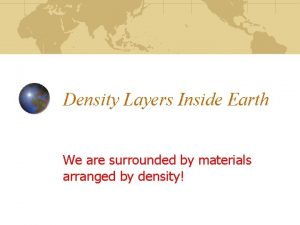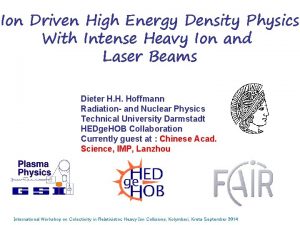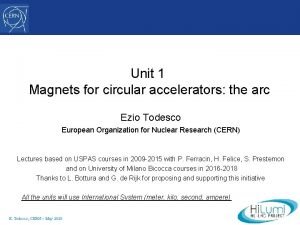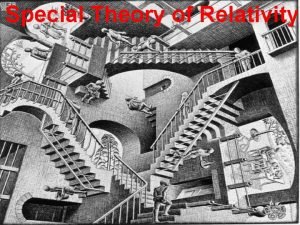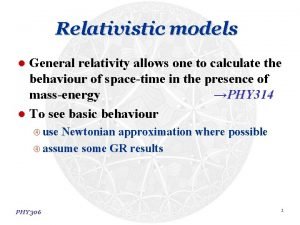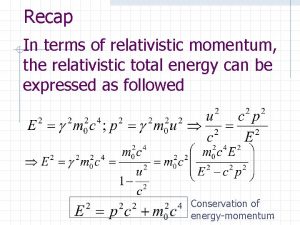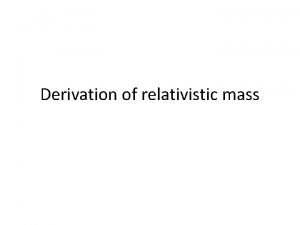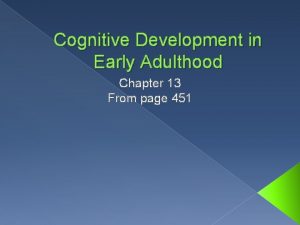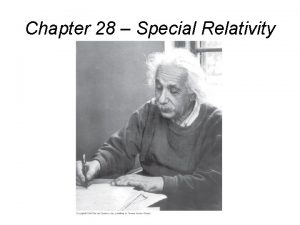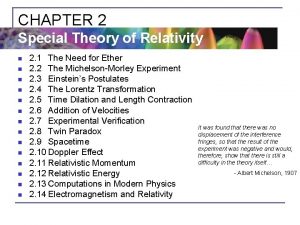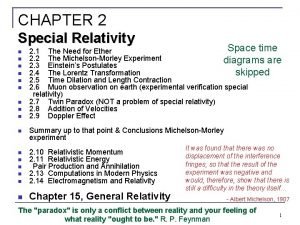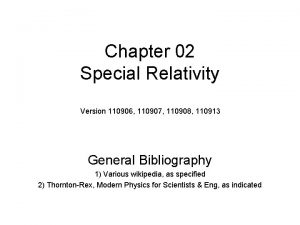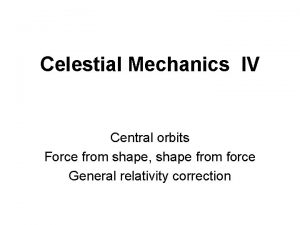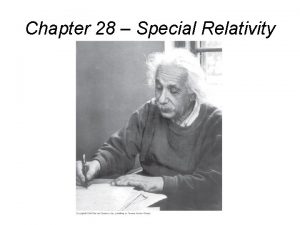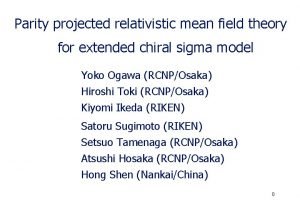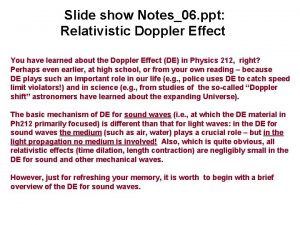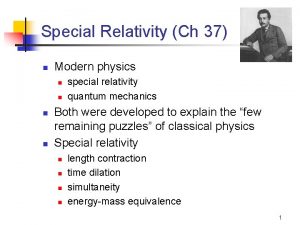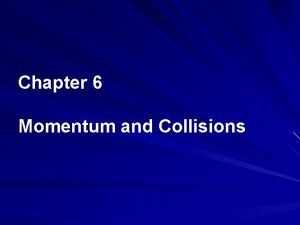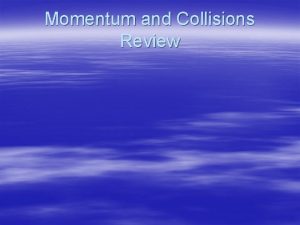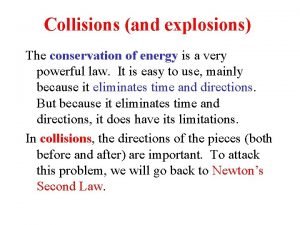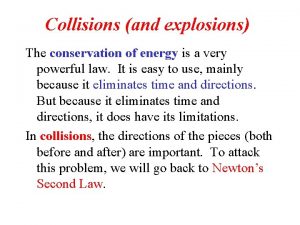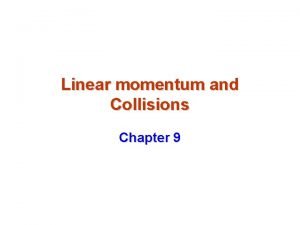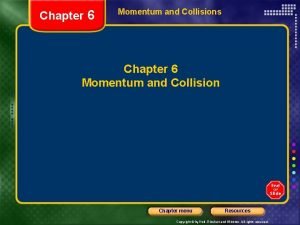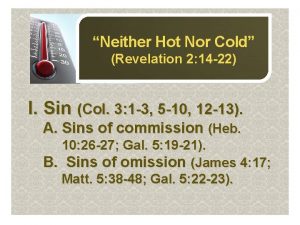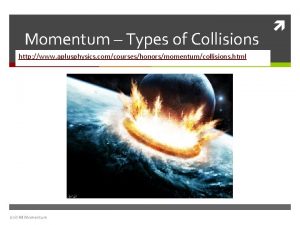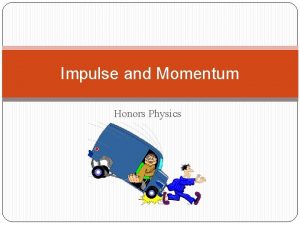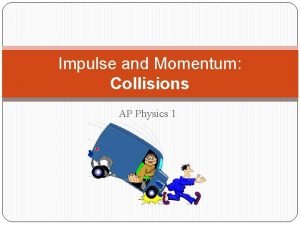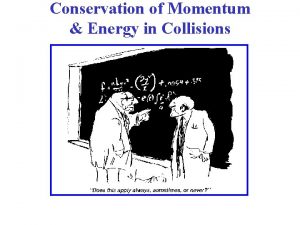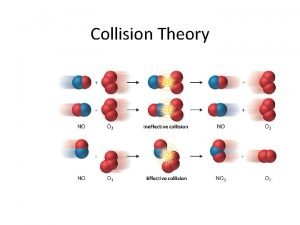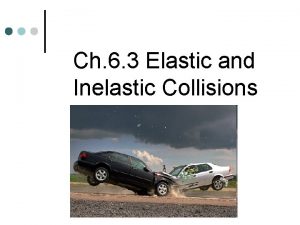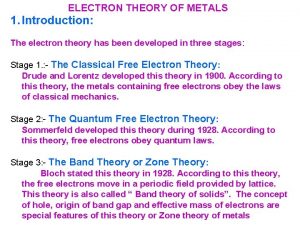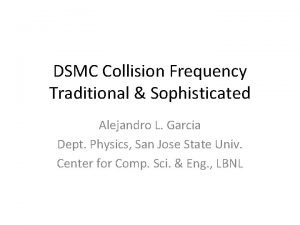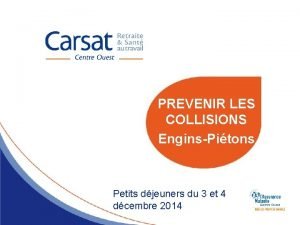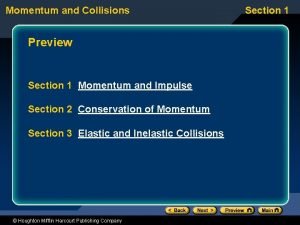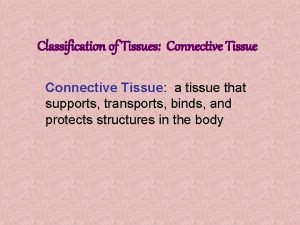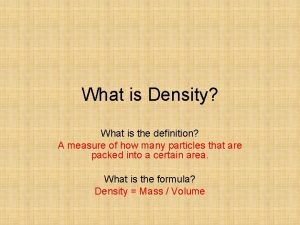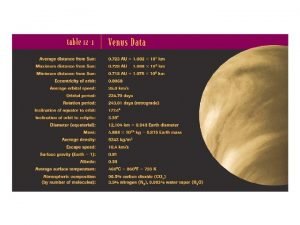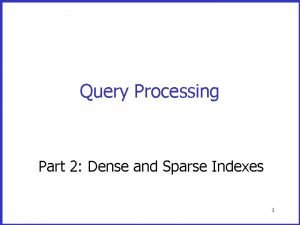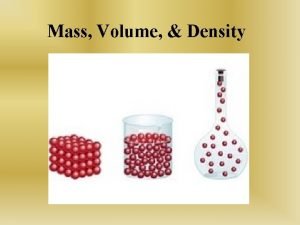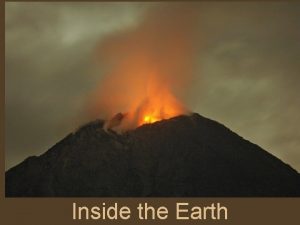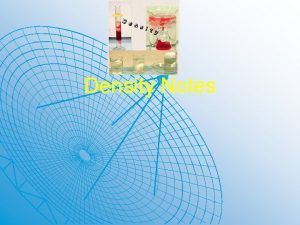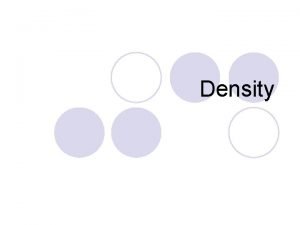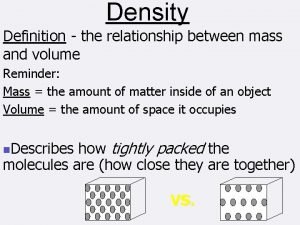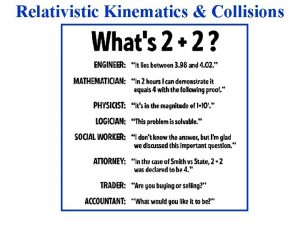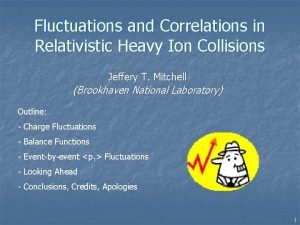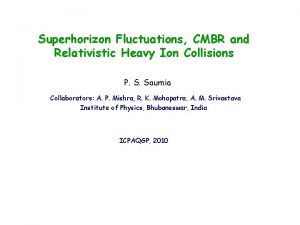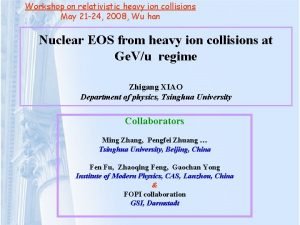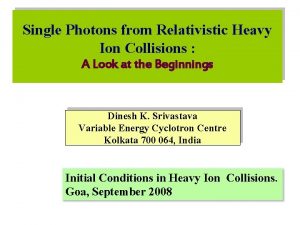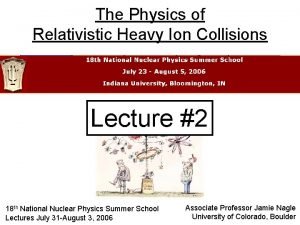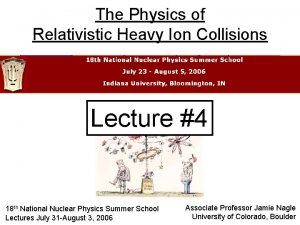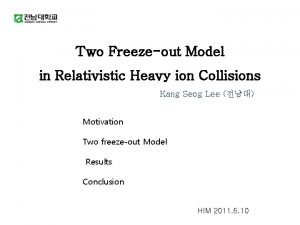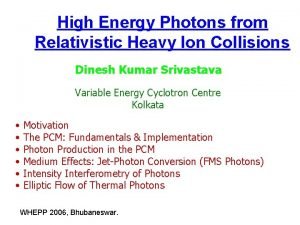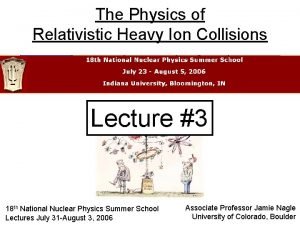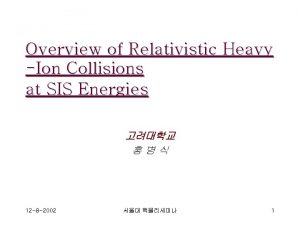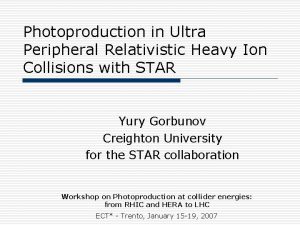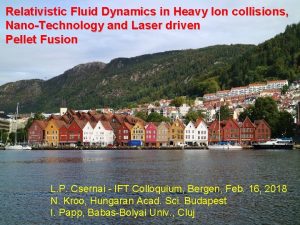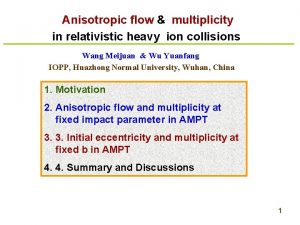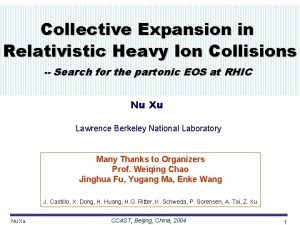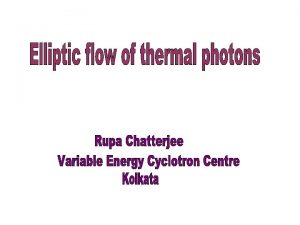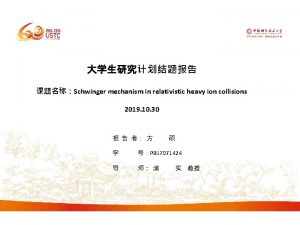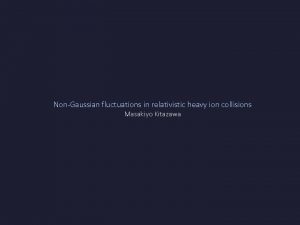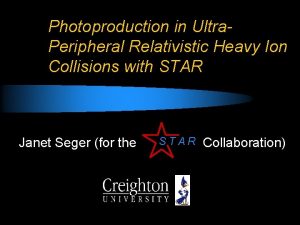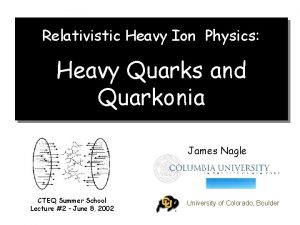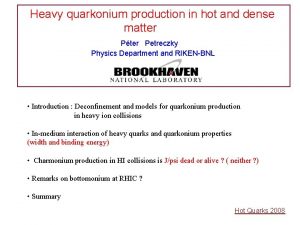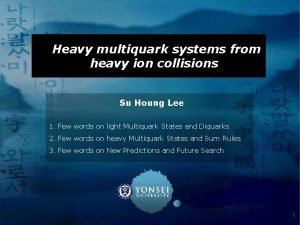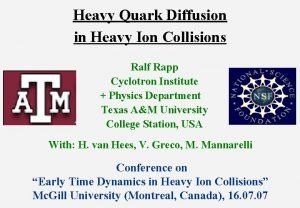Relativistic Heavy Ion Collisions and Hot Dense Matter














































































- Slides: 78

Relativistic Heavy Ion Collisions and Hot Dense Matter Che-Ming Ko Texas A&M University q Introduction: concepts and definitions - Quark-gluon plasma (QGP) - Heavy ion collisions (HIC) q Experiments and theory - Signatures of QGP - Experimental observations at RHIC - Future experiments at LHC and FAIR References: C. Y. Wong, “Introduction to High Energy Heavy Ion Collisions”, World Scientific (1994); K. Yagi, T. Hatsuda, and Y. Miaki, “Quark-Gluon 1 Plasma”, Cambridge University Press (2005)

Big Bang 2

Relativistic Heavy Ion Collisions: little bang 3

4 A quark-gluon plasma is expected to be produced during initial stage

Phases of nuclear matter Courtesy of Roy Lacey 5

QCD phase transition at zero baryon chemical potential § Energy density and pressure of free massless quarks and gluons Energy density and pressure of pion gas Bag constant B 1/4~220 Me. V 6

Quantum Chromodynamics Similar to QED but § SU(3) gauge symmetry in color space → gluon self-interaction § Approximate chiral symmetry in the light sector and is spontaneously broken in vacuum → → Eight goldstone bosons (π, K, η) and absence of parity doublets a 1 (1260) f 1 (1285) σ(400 -1200) r (770) p (140) w (782) P-S and V-A splittings in physical vacuum 7

§ Confinement at large distance → V(r) ~ k r § Asymptotic freedom at short distance → αs=g 2/4π decreases with momentum transfer 8

Lattice QCD can be solved in a discrete space Lattice QCD is the algorithm to evaluate Z in the space-time → static at finite temperature via Time dimension is thus regulated by temperature e. g. , for gluon field, the action becomes 9

Phase transition in lattice GCD Karsch et al. , NPA 698, 199 (02) 530 Me. V 410 210 0 § Soft equation of state (p< e/3) § ec ~ 6 Tc 4 ~ 0. 66 Ge. V/fm 3 § Appreciate interaction energy § Tc ~ 170 Me. V 10

Chiral symmetry restoration § Verified by lattice QCD at finite temperature and zero baryon chemical potential § Expect either appearance of parity doublets or similarity of their spectral functions, e. g, ρ and a 1 11

QCD phase diagram probed by HIC AGS SPS RHIC We do not observe hadronic systems with T > 170 Me. V (Hagedon prediction) 12

The RHIC experiments Au+Au STAR 13

Collision Geometry - “Centrality” Spectators Participants S. Modiuswescki 15 fm 0 b N_part 0 fm 394 For a given b, Glauber model predicts Npart and Nbinary 14

Rapidity distributions § Rapidity § Transverse mass § Pseudirapidity 15

Transverse momentum distributions § Soft (< 2 Ge. V/c) - exponential spectrum - bulk particle production - described phenomenologically, e. g. , string fragmentation through Schwinger mechanism 99% of particles with z= light-cone momentum fraction of produced hadron wrt that of fragmenting string § Hard (> 2 Ge. V/c) - power law spectrum - described by p. QCD 16

High p. T particle production Mini jet production c a b d hadrons Hadron prodution from empirical fragmentation function determined from e+e- annihilation ph= z pc , z <1 17

Energy Density Particle streaming from origin For Au+Au @ 200 Ge. V at RHIC R~1. 18 A 1/3~ 7 fm, d. ET/dy~ 720 Ge. V Taking particle formation time τ~0. 6 fm/c, then 18

Radial collective flow Slope of transverse momentum spectrum is due to folding temperature with radial collective expansion <βT> Absence Slopes for hadrons with different masses allow to separate thermal motion from collective flow Tf ~ (120 ± 10) Me. V <βT> ~ (0. 5 ± 0. 05) 19

Statistical model Assume thermally and chemically equilibrated system of non-interacting hadrons and resonances with density Determine chemical freeze out temperature Tch and baryon chemical potential μB by fitting experimental data after inclusion of feed down from short lived particles and resonances decay. Tch~Tc 20

Hydrodynamic model Kolb & Heinz; Teany & Shuryak; Hirano, ……. . Hydrodynamic Equations Energy-momentum conservation Charge conservations (baryon, strangeness, …) For perfect fluids without viscosity e: energy density p: pressure uμ: four velocity Equation is closed by the equation of state p(e) Cooper-Frye instantaneous freeze out dσ is an element of space-like hypersurface 21

Transverse momentum spectra from hydrodynamic model Kolb & Heinz, nucl-th/0305084 Initial flow efo=0. 45 Gev/fm-3 0. 075 Gev/fm-3 Initial Ti=340 Me. V, ei=25 Ge. V/fm 3 Freezeout Tf=128 Me. V 22

Parton cascade Bin Zhang, Comp. Phys. Comm. 109, 193 (1998) D. Molnar, B. H. Sa, Z. Xu & C. Greiner § Using αs=0. 5 and screening mass μ=g. T≈0. 6 Ge. V at T≈0. 25 Ge. V, then <s>1/2≈4. 2 T≈1 Ge. V, and p. QCD gives σ≈2. 5 mb and a transport cross section § σ=6 mb → μ≈0. 44 Ge. V, σt≈2. 7 mb § σ=10 mb → μ≈0. 35 Ge. V, σt≈3. 6 mb 23

A multiphase transport (AMPT) model Default: Lin, Pal, Zhang, Li & Ko, PRC 61, 067901 (00); 64, 041901 (01); 72, 064901 (05); http: //www-cunuke. phys. columbia. edu/OSCAR § Initial conditions: HIJING (soft strings and hard minijets) § Parton evolution: ZPC § Hadronization: Lund string model for default AMPT § Hadronic scattering: ART String melting: PRC 65, 034904 (02); PRL 89, 152301 (02) § Convert hadrons from string fragmentation into quarks and antiquarks § Evolve quarks and antiquarks in ZPC § When partons stop interacting, combine nearest quark and antiquark to meson, and nearest three quarks to baryon (coordinate-space coalescence) § Hadron flavors are determined by quarks’ invariant mass 24

Transverse momentum and rapidity distribution from AMPT BRAHMS Au+Au @ 200 Ge. V 25

What have we learnt? Matter formed in relativistic heavy ion collisions reaches § thermalization early in time τ < 1 fm/c § high initial energy density ε ~ 10 Ge. V/fm 3 § chemical equilibrium with limiting temperature Tc ~ 170 Me. V § final thermal equilibrium at Tth ~ 120 Me. V with large radial collective flow velocity <βT> ~ 0. 5 Is the matter a quark-gluon plasma? 26

Signatures of quark-gluon plasma § Dilepton enhancement (Shuryak, 1978) § Strangeness enhancement (Meuller & Rafelski, 1982) § J/ψ suppression (Matsui & Satz, 1986) § Pion interferometry (Pratt; Bertsch, 1986) § Elliptic flow (Ollitrault, 1992) § Jet quenching (Gyulassy & Wang, 1992) § Net baryon and charge fluctuations (Jeon & Koch; Asakawa, Heinz & Muller, 2000) § Quark number scaling of hadron elliptic flows (Voloshin 2002) § …………… 27

Dilepton spectrum at RHIC Min. Bias Au-Au thermal • Low mass: thermal dominant - by Rapp in kinetic model) (calculated • Inter. mass: charm decay No signals for thermal dileptons yet 28

Strangeness enhancement § In QGP 29

Strangeness quilibration Time Kinetic equation Equilibrium density 6 fm/c Strangeness equilibration time in QGP from lowestorder QCD teq ~6 fm/c is comparable to lifetime t. QGP of QGP in HIC 30

Strangeness production in hadronic matter § In hadronic matter → cross sections ~ a few mb Cross sections are unknow but expected to be a few mb as well Strangeness equilibration time in hadronic matter teq ~ 30 fm/c is 31 longer than hadronic life time thad ~ 15 fm/c

Experimental results e+e- collisions Multistrange baryons are significantly enhanced and can be accounted for by the statistical model → Strangeness equilibration 32

J/ψ suppression § Color charge is subject to screening in QGP One loop p. QCD 33

Lattice result for J/ψspectral function A(w) = w 2 r (w) J/ψdisappears between 1. 62 Tc and 1. 70 Tc 34

J/ψ absoprtion and production in HIC § Nuclear absorption: J/ψ+N→D+Λc; p+A data → σ~ 6 mb § Absorption and regeneration in QGP: § Absorption and regeneration in hadronic matter: RHIC SPS 35

Hanbury-Brown-Twiss interferometry Two-particle correlation function with § S(x, p) is the emission source function and is given by the phase space distribution at freeze out in the AMPT model § C(K, q) can be evaluated using Correlation After Burner (Pratt, NPA 566, 103 c (94)) 36

Pion interferometry STAR open: without Coulomb solid: with Coulomb Au+Au @ 130 Ge. V qinv 2=q 2 -(E 1 -E 2)2 STAR Au+Au @ 130 AGe. V Ro/Rs~1 smaller than expected ~1. 5 37

Source radii from hydrodynamic model Fails to explain the extracted source sizes 38

Two-Pion Correlation Functions and source radii from AMPT Lin, Ko & Pal, PRL 89, 152301 (2002) Au+Au @ 130 AGe. V Need string melting and large parton scattering cross section which may be due to quasi bound states in QGP and/or multiparton dynamics (gg↔ggg) 39

Emission Function from AMPT § Shift in out direction (<xout> > 0) § Strong positive correlation between out position and emission time § Large halo due to resonance (ω) decay and explosion § → non-Gaussian source 40

High PT hadron suppression Gyulassy, Levai & Vitev, PRL 85, 5535 (00) Wang & Wang, PRL 87, 142301 (01) Parton energy loss due to radiation pi k ×x pf pi ×x Jet quenching → initial energy density → 5 -10 Ge. V/fm 3 pf 41

p/π+ and pbar/π- ratios at high transverse momentum STAR Collaboration, PRL 97, 152301 (07) Same p/π+ and /π- ratios in central and peripheral collisions → Same RAA for gluon and quark jets, which is not expected from 42 radiative energy loss as gluon jets lose more energy than quark jets.

Jet conversions in QGP § Quark jet conversion Elastic process: qg→gq Gluon is taken to have a larger momentum in the final state Inelastic process: § Gluon jet conversion: similar to above via inverse reactions 43

§ Radiative conversion: 2→ 3 + ……… 44

Coalescence + jet quenching + jet conversion 45

Anisotropic flow vn Sine terms vanish because of the symmetry in A+A collisions Initial x spatial anisotropy Pressure gradient anisotropy Anisotropic flows 46

Elliptic flow from hydrodynamic model Ideal hydro describes very well data at low p. T (mass effect) but fails at intermediate p. T → viscous effect. 47

Elliptic flow from AMPT Lin & Ko, PRC 65, 034904 (2002) σp= 6 mb § Need string melting and large parton scattering cross section § Mass ordering of v 2 at low p. T as in hydrodynamic model 48

Surprise: quark number scaling of hadron elliptic flow Except pions, v 2, M(p. T) ~ 2 v 2, q(p. T/2) and v 2, B(p. T) ~ 3 v 2, q(p. T/3) consistent with hadronization via quark recombination 49

Momentum-space quark coalescence model Only quarks of same momentum can coalescence, i. e. , Δp=0 Quark transverse momentum distribution Meson elliptic flow Quark number scaling of hadron v 2 (except pions): Baryon elliptic flow same for mesons and baryons 50

Coalescence model PRL 90, 202102 (2003); PRC 68, 034904 (2003) Number of hadrons with n quarks and/or antiquarks Spin-color statistical factor e. g. Quark distribution function Coalescence probability function For baryons, Jacobi coordinates for three-body system are used. 51

Effects of hadron wave function and resonance decays Effect of resonance decays Wave function effect Higher fock states → similar effect (Duke) Wave fun. + res. decays 52

Puzzle: Large proton/meson ratio PHENIX, nucl-ex/0304022 π0 suppression: evidence of jet quenching before fragmentation PHENIX, nucl-ex/0212014 § Fragmentation leads to p/π ~ 0. 2 § Jet quenching affects both § Fragmentation is not the dominant mechanism of hadronization at 53 p. T < 4 -6 Ge. V

Large proton to pion ratio Quark coalescence or recombination can also explain observed large p/pi ratio at intermediate transverse momentum can be in central Au+Au collisions. OREGON TAMU DUKE 54

Higher-order parton anisotropic flows Including 4 th order quark flow Kolb, Chen, Greco, Ko, PRC 69 (2004) 051901 Meson elliptic flow Baryon elliptic flow 55

Higher-order anisotropic flows Data can be described by a multiphase transport (AMPT) model with large parton cross sections. Data Parton cascade gives v 4, q~v 2, q 2 56

Charmed meson elliptic flow Smaller charm v 2 than light quark v 2 at low p. T due to mass effect S. Kelly, QM 04 v 2 of electrons Greco, Rapp, Ko, PLB 595 (04) 202 Data consistent with thermalized charm quark with same v 2 as light 57 quarks before boosted by radial flow

Charm RAA and elliptic flow from AMPT Zhang, Chen & Ko, PRC 72, 024906 (05) § Need large charm scattering cross section to explain data § Smaller charmed meson elliptic flow is due to use of current light quark masses 58

Resonance effect on charm scattering in QGP Van Hees & Rapp, PRC 71, 034907 (2005) With mc≈1. 5 Ge. V, mq≈5 -10 Me. V, m. D≈2 Ge. V, ΓD≈0. 3 -0. 5 Ge. V, and including scalar, pseudoscalar, vector, and axial vector D mesons gives σcq→cq(s 1/2=m. D)≈6 mb Since the cross section is isotropic, the transport cross section is 6 mb, which is about 4 times larger than that due to p. QCD t-channel diagrams, leading to a charm quark drag coefficient γ ~ 0. 16 c/fm in QGP at T=225 Me. V. 59

Heavy quark energy loss in p. QCD a) Radiative energy loss (Amesto et al. , hep-ph/0511257) b) Radiative and elastic energy loss (Wicks et al. , nucl-th/0512076) a) + c) Three-body elastic scattering (Liu & Ko, nucl-th/0603004) a) +b) + § May be important as interparton distance ~ range of parton interaction § At T=300 Me. V, Ng~(Nq+Nqbar)~ 5/fm 3, so interparton distance ~ 0. 3 fm § Screening mass m. D=g. T~600 Me. V, so range of parton interaction ~ 0. 360 fm

Spectrum and nuclear modification factor of electrons from heavy meson decay Reasonable agreement with data from Au+Au @ 200 A Ge. V after including heavy quark three-body scattering. 61

Net charge fluctuations Adams et al. , STAR Collaboration, PRC 68, 044905 (2003) Au+Au @ 130 Ge. V Charge Conserv a tion Quark Co a lescence Resonanc e Gas Quark. Gluon Plasma Favor quark coalescence picture for hadronization 62

Heavy ion collisions at LHC 63

Rapidity distributions at LHC Pb+Pb @ 5. 5 Te. V b< 3 mb σparton=10 mb Particle multiplicity at LHC increases by a factor of ~ 4 from that at RHIC 64

Transverse momentum distributions 0 < b < 3 fm Particle transverse momentum spectra are stiffer at LHC than at RHIC → larger transverse flow 65

Quark elliptic flows Au+Au @ 200 Ge. V Quark elliptic flows are larger at LHC than at RHIC, reaching ~ 20% 66

Pion and proton Elliptic flow at LHC Elliptic flow is larger for pions but smaller for protons at LHC than at RHIC 67

Heavy meson elliptic flows at LHC Quark coalescence model 68

Pion interferometry Two-pion correlation functions narrower at LHC than at RHIC 69

Radii from Gaussian fit to correlation functions Source radii for pions are larger than for kaons and both are larger at LHC than at RHIC 70

Thermal charm production in QGP Zhang, Liu & Ko, PRC 77, 024901 (08) mc=1. 3 Ge. V § Thermal production non-negligible § Next-leading order and leading order contributions are comparable § Insensitive to gluon masses § Effect increases by about 2 for initial temperature T 0=750 Me. V but decreases by ~ 2 for mc=1. 5 Ge. V 71

Diquark in s. QGP and Λc enhancement Lee, Yasui, Ohnishi, Yoo & Ko, PRL 100, 222301 (08) Diquark mass due to color-spin interaction: for mu=md= 300 Me. V and C/mu 2~195 Me V from mΔ-m. N Coalescence model Statistical model • Enhanced by a factor of 4 -8 • Similar for ΛB/B 0 72

Charm exotics production in HIC Lee, Yasui, Liu & Ko Eur. J. Phys. C 54, 259 (08) § Charm tetraquark mesons - Tcc ( ) is ~ 80 Me. V below D+D* according to quark model - Coalescence model predicts a yield of ~5. 5 X 10 -6 in central Au+Au collisions at RHIC and ~9 X 10 -5 in central Pb+Pb collisions at LHC if total charm quark numbers are 3 and 20, respectively - Yields increase to 7. 5 X 10 -4 and 8. 6 X 10 -3, respectively, in the statistical model § Charmed pentaquark baryons - Θcs( ) is ~ 70 Me. V below D+Σ in quark model - Yield is ~1. 2 X 10 -4 at RHIC and ~7. 9 X 10 -4 at LHC from the coalescence model for total charm quark numbers of 3 and 20, respectively - Statistical model predicts much larger yields of ~4. 5 X 10 -3 at RHIC and ~2. 7 X 10 -2 at LHC 73

Mapping the QCD phase diagram at FAIR Require first-order phase transition ? 74

Rapidity distributions at FAIR 75

Elliptic flow at FAIR Partonic scattering enhances elliptic flow Mass ordering of hadron elliptic flows 76

Comparison of transport model predictions of elliptic flow at FAIR 77

Summary § Most proposed QGP signatures have been observed at RHIC. § Strangeness production is enhanced and is consistent with formation of chemical equilibrated hadronic matter at Tc. § Large elliptic flow requires large parton cross sections in transport model or earlier equilibration and small viscosity in hydrodynamic model. § HBT correlation is consistent with formation of strongly interacting partonic matter. § Jet quenching due to radiation requires initial matter with energy density order of magnitude higher than that of QCD at Tc. § Quark number scaling of elliptic flow of identified hadrons is consistent with hadronization via quark coalescence or recombination. § Electromagnetic probes and heavy flavor hadrons will be studied by upgrated RHIC. § Experiments at LHC and future FAIR allow for probing QGP at even higher temperature and finite baryon chemical potential, respectively. 78
 Crust outer core inner core mantle
Crust outer core inner core mantle The layers of earth from most dense to least dense
The layers of earth from most dense to least dense Earth's layers most dense to least dense
Earth's layers most dense to least dense Ratey method
Ratey method Heavy ion
Heavy ion Cognitive development early adulthood
Cognitive development early adulthood Ion dipolo
Ion dipolo Qumica
Qumica Qué son las fuerzas intramoleculares
Qué son las fuerzas intramoleculares Vapor pressure intermolecular forces
Vapor pressure intermolecular forces Relativistic circular motion
Relativistic circular motion Relativistic thinking example
Relativistic thinking example Length contraction
Length contraction Al's relativistic adventures
Al's relativistic adventures General relativity formula
General relativity formula Relativistic momentum
Relativistic momentum Relativistic thinking example
Relativistic thinking example Relativistic mass formula
Relativistic mass formula Cognitive development in early adulthood
Cognitive development in early adulthood Relativistic kinetic energy
Relativistic kinetic energy Relativistic velocity
Relativistic velocity Kinetic energy of a relativistic particle
Kinetic energy of a relativistic particle Relativistic kinetic energy
Relativistic kinetic energy Clairaut equation
Clairaut equation A physical education chapter 28
A physical education chapter 28 Relativistic mean field theory
Relativistic mean field theory Doppler effect animation ppt
Doppler effect animation ppt Relativistic momentum
Relativistic momentum Grey matter of nervous system
Grey matter of nervous system What makes up the diencephalon
What makes up the diencephalon Gray matter and white matter
Gray matter and white matter Telecephalon
Telecephalon Elastic vs inelastic
Elastic vs inelastic A small marble collides with a billiard ball
A small marble collides with a billiard ball A roller coaster climbs up a hill at 4m/s and then
A roller coaster climbs up a hill at 4m/s and then Inelastic collision
Inelastic collision Collisions and explosions
Collisions and explosions Collisions and explosions
Collisions and explosions What is elastic collision
What is elastic collision Chapter 6 momentum
Chapter 6 momentum White hot vs red hot temperature
White hot vs red hot temperature Hot working of metal is
Hot working of metal is Perbedaan hot lava dan hot lava volcano
Perbedaan hot lava dan hot lava volcano Be either hot or cold
Be either hot or cold Classification of matter section 1 composition of matter
Classification of matter section 1 composition of matter Section 1 composition of matter
Section 1 composition of matter Chapter 2 section 1 classifying matter answers
Chapter 2 section 1 classifying matter answers Section 1 composition of matter chapter 15 answer key
Section 1 composition of matter chapter 15 answer key Energy naturally flows from warmer matter to cooler matter
Energy naturally flows from warmer matter to cooler matter Types of collisions/ impulse graphs answer key
Types of collisions/ impulse graphs answer key Types of collsions
Types of collsions Ap physics collisions
Ap physics collisions To avoid collisions a defensive driver should
To avoid collisions a defensive driver should Does an elastic collision conserve momentum
Does an elastic collision conserve momentum Energy diagram
Energy diagram Elastic potential energy real world examples
Elastic potential energy real world examples Elastic collision video
Elastic collision video Momentum is conserved in all collisions
Momentum is conserved in all collisions When you move into the deceleration lane, you should
When you move into the deceleration lane, you should Electron theory of metals
Electron theory of metals Collision frequency
Collision frequency To avoid collisions a defensive driver should
To avoid collisions a defensive driver should Prévention des collisions engins-piétons
Prévention des collisions engins-piétons Collisions
Collisions Are very dense warm
Are very dense warm Are very dense warm
Are very dense warm Connective tissue description
Connective tissue description Loose connective tissue
Loose connective tissue Density definition
Density definition Surface of venus
Surface of venus Dense index vs sparse index
Dense index vs sparse index Mass volume density video
Mass volume density video Which layer is the least dense
Which layer is the least dense Dense ball of solid metal
Dense ball of solid metal Is oil more dense than water
Is oil more dense than water Density of a golf ball
Density of a golf ball Use of density
Use of density Whats the relationship between mass and volume
Whats the relationship between mass and volume Densepose: dense human pose estimation in the wild
Densepose: dense human pose estimation in the wild


